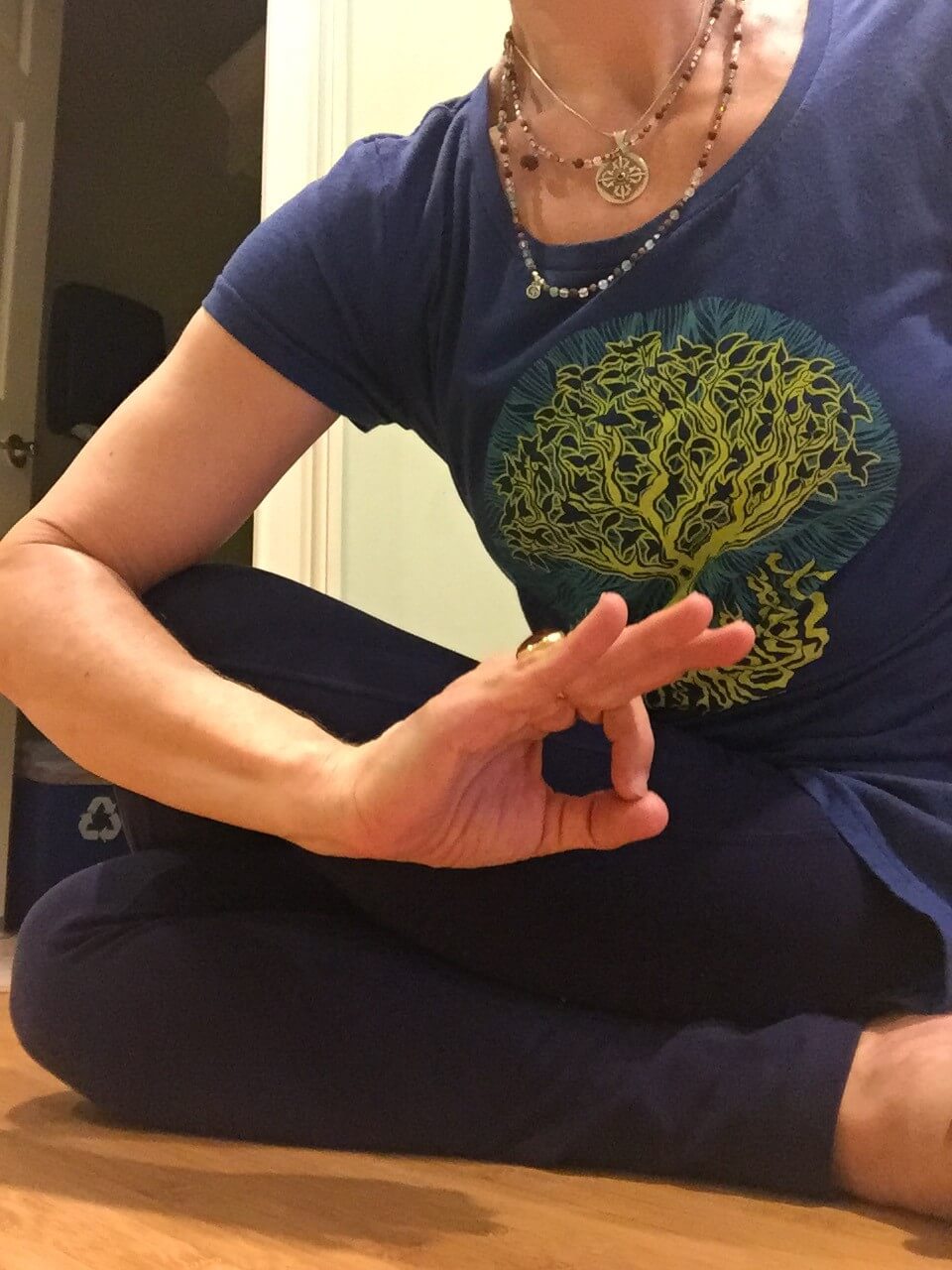Think yoga isn’t a cardio-vascular practice? You’ve maybe never practiced the rigorous pace of Ashtanga Vinyasa Yoga. I was practicing Intermediate Series on a random Sunday in a mysore-style class. (Mysore-style means the class is self-led but also assisted by a great teacher.) Following the 8 initial backbends of this sequence, my heart seemed to be beating out of my chest. Each backbending pose was followed by a vinyasa, so there was no obvious “recovery” place. A few soothing postures later, my heart re-accelerated from jumping into Bakasana (crane aka crow pose) and then again after jumping two legs up into Pincha Mayurasana (peacock feather pose aka forearm balance). This cycle of pounding-heart-rate-up-soothing-heart-rate-down continued on and off until I got to the end of finishing series and tick-tocks. Ugh. Tick-tocks.
Blog Image 
Having emotionally resolved my initial fright of tick-tocks (jumping into handstand, dropping feet to the ground overhead into an upward facing bow and jumping right back up into handstand to land back where you started), I was now faced with this outrageously velocious heart-rate. I wasn’t afraid to do the tick tocks, I just didn’t know how to mentally overcome this pounding in my chest. It’s not like I haven’t experienced an elevated heart beat. It’s no different than going on a run, being in a spinning class or going cross-country skiing — all of which I’ve done in my life.
So, there are am standing, waiting for my heart rate to calm down. Up walks the no-nonsense mysore teacher and says, “Ready for tick-tocks?” I took a cleansing breath (a loud one), and replied, “Yeah, but my heart rate is so high, I just don’t know…..”. Two heart beats later she says to me,
“Fine. Paschimottanasana.”
What? Just like that? No emphathic discussion?
Nope. Case closed. Message sent. We here in the ashtanga room will not listen to your excuses, so shut up, finish and go home. Try again tomorrow, but you do not get to try again right now.
I was all geared up in my own head about the legitimacy of my excuse for not getting right to the tick-tock. Because the teacher didn’t step aboard my justification-train and join in my excuse, she left me sitting with it for 10 long breaths in paschimottanasana. I then sat with it during my shower. I pondered it while I dried my hair. I contemplated it while getting dressed. Sigh. Yup – Ignorance. Avidya.. A new layer of ignorance disguised in a different package. It showed up not in a posture, but in my heart-rate.
Blog Image 
The Afflictions That Arise in Yoga
Affliction is a funny word when used to label yoga practitioners’ thought processes. It means there is a disorder of the thinking that leads to torment — suffering. There are five kleshas (afflictions of the mind) described in Patanjali’s Yoga Sutras ( II.3 “Ignorance, egoism, desire, aversion and fear of death are the afflictions.”) Ignorance is the ultimate klesha. If Avidya (ignorance) can be conquered and overcome, all the other kleshas topple like dominoes.
Avidya is about misunderstanding the unreal for the real. In yoga, “real” is defined as that which never changes. Placing too much importance on the aspects of life that change constantly is considered ignorant thinking.
That’s what makes asana practice so powerfully interesting. From the outside, it looks like we are just doing exotic gymnastics, but that is not the point at all. All the improvements of the body we attain in asana practice have to be surrendered at the end of the life. The body is just a rental unit, after all. It’s not permanent. The body changes just like:
weather
life’s circumstances
relationships
jobs
well-laid plans
thoughts
attitudes
opinions
These things just don’t last. They are constantly changing. Because they are unstable, in yoga philosophy, they are not real.
If I were to “get real” I’d realize that not only am I not my body, I am also not my heart-rate. I am not really a woman. I am not actually a mother or a housewife. I am the consciousness (soul) experiencing these manifestations. Lesson heard.
But I think this will take some practice.
Just as it’s important not to get mentally unhinged by the body, we can’t get derailed by the up and down of the energy of the body. Improvements we make in the mind such as being less reactive, more emotionally resilient and adaptable to the constant changes we experience, those we get to keep for next time.
The practice of yoga provokes us to detach and to not over-identify with the physical, material and impermanent aspects of incarnation. It’s easy to say we don’t identify with the body, but it’s quite another layer to actually be confronted and provoked into choosing the aspect with which you most connect.
Vanquishing the Torment
The practice of Kriya Yoga is supposed to free us from the controlling-bondage of the kleshas. Kriya Yoga is the combined application of three niyamas (personal practices) those being: tapas, svadhyaya and ishvarapranidhana. Kriya Yoga helps us manage the solvable vs. the unsolvable aspects of practice. It’s the preparatory practice that governs the changes we make that stick with us beyond this life into the next.
That’s what makes this crazy-looking ashtanga practice so potent and so useful. “You come up against your sh*t all the time..” — Thanks Shanna Small — so true. As soon as you think you get past one klesha, you realize, Damn! there is another layer to this!
Tapas is translated as austerity, but can be better understood as simplicity. (Tapas as simplicity comes from Gregor Maehle’s book “Ashtanga Yoga: Practice & Philosophy”, page 184….you should read this and ALL his books!) The application of tapas means that you endure the discomfort associated with changing your mental patterns no matter whether it is emotional or mental. The heat of tapas transforms your physicality. It also means you keep it simple by not engaging in excuses or distractions. To be tapasic means you bypass the desires that don’t serve the goal at hand. Tapas is the horizontal force that governs the changeable material/earthly aspects we seek to improve. It means tackling the solvable problems head-on.
Ishvarapranidhana is the acceptance that there is a Supreme Being/Energy and that you are an inherent part of that. Each of us has a body, but we are not the body any more than we are the house in which we live or the car we drive. Just like a house or a car, the body is the dwelling place — the vehicle of the soul. As such, it is separate, conscious, independent, stable, still and aware. It is energy that can never be created nor destroyed, but it can manifest and unmanifest.
Unlike the consciousness, the body and the mind are different. They are inherently unconscious, dependent, always changing, always moving and unaware except through the luminosity of purusha (consciousness). Your body is always changing and aging. Your mind (thinking) can be clear or flawed (aka unreliable) especially when emotions are involved. Getting closer to the stable luminosity of the soul is the goal of yoga. It leads to that constant happiness that is unshakable by events, circumstances and people around us. It is also quiet, peaceful and easy with what is. Being identified with purusha makes you easy with life and others.
When something seems unsolvable or impossible, we are to surrender that aspect of practice up to Ishvara. Who is Ishvara? It’s whoever you pick as your own personal god, deity, or divine representative. It’s giving yourself over to the vertical, upward moving force beyond the material aspects of practice when you think something is not solvable. It’s called “letting go” or “surrendering up”. It helps us deal with the past and the things we cannot change or that are not solvable.
Svadhyaya is the place between tapas and Ishvarapranidhana. Svadhyaya can mean studying scriptures, but on a more profound level, Svadhyaya means studying your emotional and mental landscape. It’s the part that scrutinizes whether or not a problem is solvable or unsolvable. Svadhyaya is where you take ownership of e-v-e-r-y-t-h-i-n-g you say, do and think. You own the solution. You also own the responsibility for releasing what you can’t solve.
Untangling and Redirecting the Mind
Creating positive change requires self-reflection. Reflecting, pondering and self-examining is part of spiritual practice. THAT is the part of yoga that can feel dark, difficult and demanding. It’s a rough, steep path to clean up the emotions, the attitudes, the emotional outbursts, and the reactivity that are woven into our mental terrain.
Often we inhabit that terrain unconsciously. Shedding light on the unfamiliar, dark mental contours can be an unexpected shock that leaves us feeling exposed, vulnerable and raw. It’s easy to lay the blame for the shock at the feet of other people (like a strong teacher) or on the difficult demands inherent to the practice.
Really, though, we should have the courage to own it ourselves.
So. Tomorrow, my practice is new because I have a new perspective. I get back on the mat and I try again with a crisp awareness. I use the asana practice to release the past from my body. I use the mind’s focus on breath to keep me in the present moment.
That harmony changes my future.
Mara wore the Tree of Life Ebb and Flow Top
![]()



